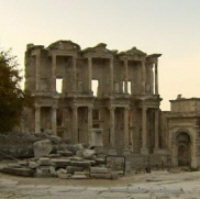Virgin Mary
Ephesus. Theotokus
On April 1, 527 A.D., the reigning Justin named Justinian and Theodora as his successors. Three days later, on Easter Sunday, the correlation was held
here in Hagia Sophia. Theodora, the girl who started life in the gutter, was now in command of a vast Empire. And she was the most powerful women in
the whole of Christendom.
As the Empress of the first Empire ruled by one God, Theodora was now allied to the most powerful woman in heaven, Mary, the mother of God himself.

Ephesus
When you think of Theodora and her relationship to the Virgin Mary, is really important to mind-shift back to the sixth century A.D., because it had
only been relatively recently that the young girl from Nazareth had been turned into something quite extraordinary.
At the ancient city of Ephesus, in southern Turkey, in 431 A.D., leaders arrived from all across Christendom to settle fundamental issues of the
Christian faith.
I'm meeting historian Kate Cooper to find out how decisions taken here would shape Theodora's world.
Kate "This is THE question. It's the nature of Jesus. Is he human? Is he a God? Or is he some combination of the two? And, of course, it's really whether
or not his mother gave birth to a god or a human that it all boils down to. Whether or not she was 'Theotokus', is the Greek for it. 'God-bearer'. That
was the hottest topic of debate as you can imagine."
The location of the council was no coincidence. For thousands of years Ephesus had been home to the pagan goddess Artemis, the virgin goddess of
childbirth. Those early Christians who wanted to elevate Mary to the mother of God where connecting her to the power of the great goddesses who had
once held sway across the world. And this movement had some influential supporters. Imperial women who wanted to put a girl next to God.
Kate Cooper
Kate "If you think from the perspective of the women, it's the women of the Imperial household who really want the cult of the Virgin, which in a
sense, is there cult, to gain the honour that it deserves in the official church, as well as in the Imperial family. For the Imperial women, there is
a sort of wonderful hall-of-mirrors effect that they are venerating the Virgin, but they are also having that kind of glory reflected back on them,
that they are themselves powerful."
Theodora
Do they almost morph into the Virgin at any point? Is there a sense that, in some ways, they incarnate her?
Kate "I certainly think that's something that is always at the edge of everyone's mind, this idea that the Virgin Mary, the mother of God, the Queen of
Heaven, is the direct counterpart of the Empress here on earth."
With the support of the women of the Imperial household, the Council of Ephesus decreed that Mary was not just the mother of Christ, but "Theotokus", the
mother of God.
This mosaic from a church in Ravenna is the only contemporary image of Theodora, and it drives home this divine connection to the Virgin Mary.
On one side of the church is the Emperor Justinian, flanked, like Jesus, by 12 Apostles. On the opposite wall is Theodora, portrayed as the mother of
God, with the halo round her head. And embroidered on the hem of her robe are the three Kings, who came to pay court to Mary and the baby Jesus.
Justinian and Theodora presided over the Imperial Court as if it was the court of judgement in heaven. He was God and she was the Virgin Mary.
Justinian and Apostles
Those who were allowed access, prostrate themselves and press their foreheads into the ground. And the senator's were allowed to brush the Imperial feet
with their lips. I bet Theodora loved every minute of it!
Justinian and Theodora made their mark throughout their sacred Empire. In Constantinople, they built the great church of Hagia Sophia. In Egypt, their
names were carved in the beams of the church of the mother of God on Mount Sinai. And in Greece, the Parthenon, on the Acropolis, was now home to Mary,
the mother of God.
New Excavation
Theodora remains an elusive figure. The accounts we have of Theodora are so highly coloured, it can sometimes feel hard to get close to the physical
reality of her life. But after being buried for 1500 years, this extraordinary new excavation is bringing us closer to the great city that she lived in.
As foundations are laid for a new metro line, the ships being uncovered here tell us how closely connected Constantinople was to a vast Empire.
At this point in history, Theodora ruled over a territory that spanned three continents – Europe, Asia and Africa. Evidence of her influence can be
found, not just in the Earth, but in words on a page. Together with Justinian, she introduced a radical series of reforms, buildings safe houses for
homeless women, banning prostitution and outlawing infanticide.
